A Tale of Two 'Extreme Weather Events'*
*EWEs used to be called storms
Destructive Nature, Then and Now
Coincidentally, the front pages of the Chicago Tribune of 28 September 2024 and the same date in 1932 both feature stories about destructive hurricanes. (Yes, Virginia, there were hurricanes even back then.) The respective front pages of the Trib, which in 1932 was the Chicago Daily Tribune and boasted of being The World’s Greatest Newspaper on its masthead:
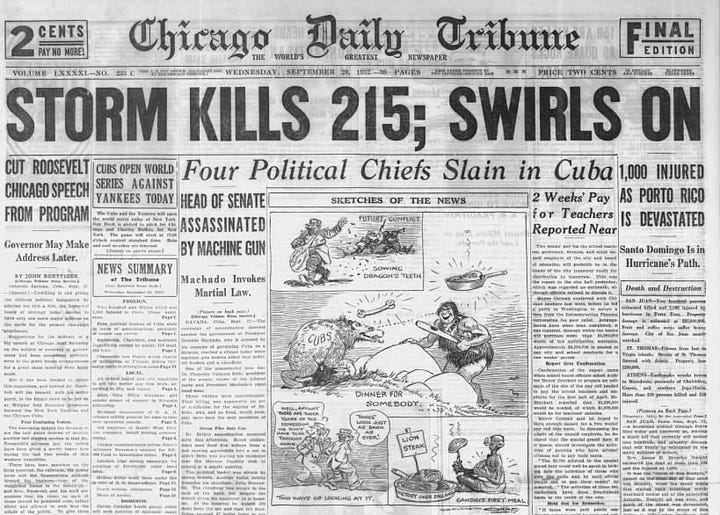

My first reaction upon seeing the headline of the 2024 edition was that there would inevitably be mention of climate change as a contributing factor, if not the outright cause of the hurricane. In 1932, the Tribune’s owner and publisher was Robert Rutherford "Colonel" McCormick. Popularly known as The Colonel, McCormick was a conservative, anti-war isolationist (Yes, the Republican Party was the anti-war party, then.) and arch-enemy of Franklin Delano Roosevelt. Much to McCormick’s chagrin, Roosevelt had been nominated as the Democrat Party’s presidential candidate earlier in the year at the Democrat National Convention in Chicago. The Tribune would go on to endorse Herbert Hoover for reelection and be a constant thorn in FDR’s side as he, in The Colonel’s view, tried to communize the nation.
Weather was weather in 1932. It could be good, bad or indifferent. Even intellectuals believed that there was not much that could be done about the weather except endure it. In fact, anyone who claimed to be able to affect the weather through prayer, soothsaying, rain dance or sheer will was thought to be a bit daft.
“If you don’t like the weather in New England,” Mark Twain allegedly said, “just wait 15 minutes. It will change.”
Floods, droughts, dust bowls, tornados and hurricanes were all a part of life, acts of God (now acts of Allah). Not much could be done about it except to wait it out. Things would eventually get better. A sort of cock-eyed optimism ruled. Besides, there were more urgent matters to worry about, such as the Great Depression and rumblings of war in Europe with the growing strength of dictators Joseph Stalin, Adolph Hitler and Benito Mussolini raising concern. The Japanese and Chinese were also stirring things up in The Orient.
Today, the Tribune has done a 180° turn to the political left. The Colonel must be doing the roll over in his crypt thing in extremis. Trib editors are right in line with the mainstream media’s woke narrative, supporting and covering for Democrats and their far-out, far-left agenda. Even as the Windy City is caught in a death spiral of corruption, population and business loss, failing schools, huge deficits and a plague of illegal immigrants flocking to the Windy City turned Sanctuary City in search of benefits denied to its own (Blacks in particular) residents, the Tribune remains a staunch Democrat Party mouthpiece.
Today’s Tribune article does not disappoint on the climate change front. The reader has to wait until the seventh paragraph, but there it is:
Climate change has exacerbated conditions that allow such storms to thrive, rapidly intensifying in warming waters and turning into powerful hurricanes and typhoons, sometimes in a matter of hours….
Helene was the eighth named storm of the Atlantic hurricane season, which began June 1. The National Oceanic and Atmospheric Administration has predicted an above-average Atlantic hurricane season this year because of record-warm ocean temperatures.
In fact, it has been a relatively mild hurricane season although there is no doubt about the massive destruction as a result of Helene’s fury. Despite evidence to the contrary, very smart people believe in the holy writ of climate change and hold a religious like faith that we are in the process of succumbing to global boiling, in U.N. Secretary General António Manuel de Oliveira Guterres’ words. As economist Thomas Sowell, among others, has said, it takes an intellectual to believe such nonsense.
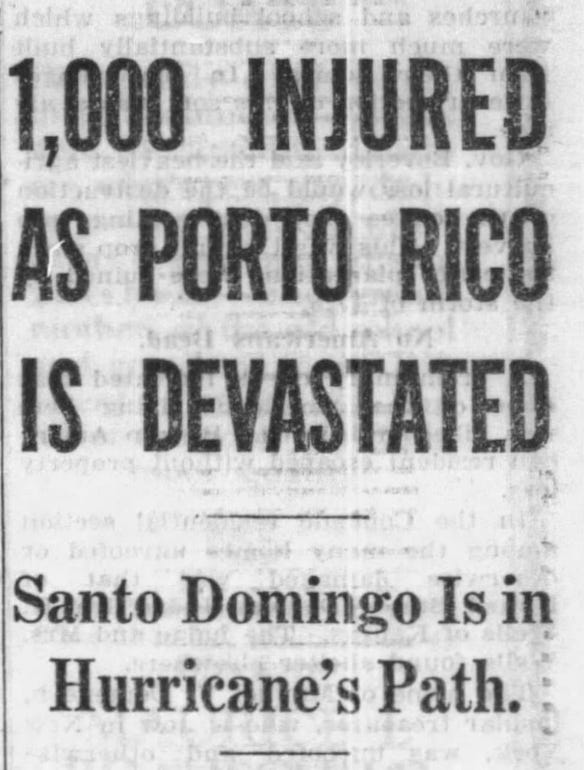
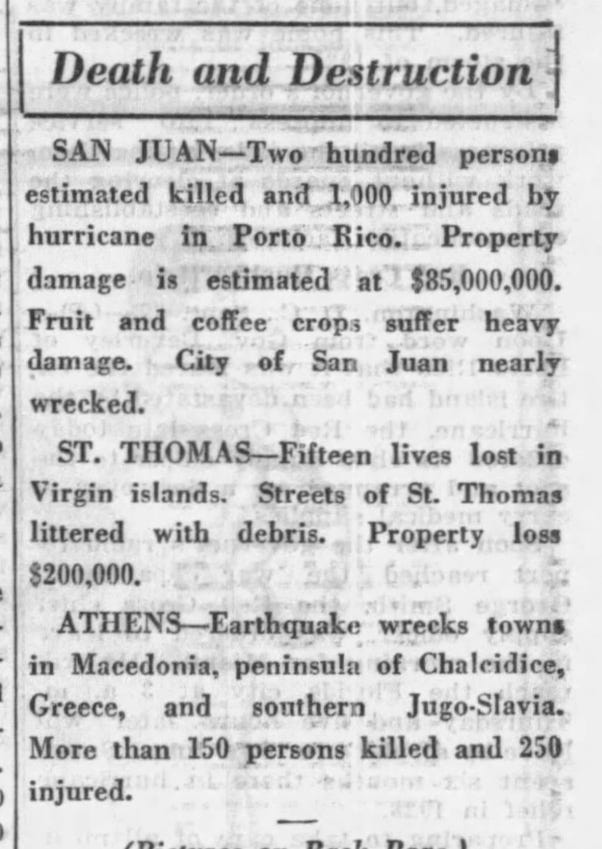
The Storm of San Eusepio
The lede paragraph from the 1932 Chicago Daily Tribune article:
SAN JUAN, Porto Rico, Sept. 27. -A hurricane swirled through Porto* Rico (sic) today and lumbered on, leaving a death toll that probably will mount into hundreds, and property damage that will finally be calculated in the many millions of dollars.
Gov. James R. Beverley, tonight estimated the dead at more than 200 and the injured at 1,000. It was the "storm of San Eusepio," named on the feast day of that saint last Monday, when the dread winds first started their relentless north- westward course out of the equatorial Atlantic. Tonight all was over, and much of the island was devastated, just as it was by the storm of San Felipe, in 1928, when hundreds lost their lives and $85,000,000 ($19,531,138,686.13 today) in property damage was wrought.
Heads for Santo Domingo.
It was feared, however, that the hurricane's work of destruction is not finished. Tonight it was reported headed directly for Santo Domingo, capital of the republic of Santo Domingo, and for Port au Prince, Haiti. Reports from Santo Domingo said strong winds swept into the city at 8:30 o'clock tonight and that heavy rain had begun to fall.
Recall that there was no FEMA at this time. Communication facilities were primitive, and the storm knocked out telephone and telegraph service. It was up to Governor James R. Beverly, Governor of Puerto Rico, to organize relief efforts. Note that he had to use couriers to communicate with distant regions.
After the storm had left Porto Rico Gov. Beverley lost no time in starting relief machinery. He formed an emergency committee and gave it instructions to find shelter and food for the many thousands of destitute and homeless. He promised that insular funds would be placed in the committee's hands tomorrow, pending a definite relief program.
Reports Many Towns Leveled.
The governor's couriers, sent out to gather information on the hurricane, brought him back information upon which he based his estimate of the dead and injured. He said this estimate (at least 200 dead; 1000 injured) undoubtedly would be revised upward. Because of broken communication lines there was no way of telling how many dead there were. Rafael Veve, Jr., assistant general manager of the Fajardo Sugar company, arrived in the capital late today after a fatiguing journey of eight hours from Fajardo, only 30 miles away.
"All the towns between Fajardo and Carolina, more than half the distance to the capital, were leveled," Velve said. "All the plantation houses were destroyed.
"There were 39 dead at Fajardo when I left at 8 a. m. and I saw about 100 dead between Fajardo and Carolina. I can well imagine thousands dead in the districts I traversed."
In addition to loss of life and property, destruction of fruit and coffee crops was ruinous. The governor estimated that damage to the fruit crop was $7,000,000 ($160,844,671.53 today). He said that coffee crop losses would be even higher.
To make matters worse, the coffee crop was just being readied for harvest. It would have been the first coffee harvest in Puerto Rico since the coffee plantations were wiped out by the hurricane of 1928.
Final figures for loss of life and total damages from the 1932 hurricane vary slightly depending on source. One thing to keep in mind is that the population of the island was only about 1.5 million people, about half of what it is today. That made the magnitude of the losses per capita that much greater. In retrospect, what is now referred to as the San Ciprián hurricane was one of the most devastating to ever hit Puerto Rico.
The 1932 San Ciprián hurricane was one of the strongest tropical cyclones in the history of Puerto Rico. The center of the storm traversed the island on an east-to-west path in late September 1932, killing 272 people and inflicting at least $35 million in damage.
[According to the Red Cross], 76,925 families were in "actual distress" due to the hurricane.[4] The destruction of homes rendered 25,000 families homeless.[24] Total economic losses from the storm were equivalent to 20 percent of Puerto Rico's gross income.[25]
Despite the historical record and more accurate contemporary data sets, internet climate catastrophists continue to blame every flood, tornado, hurricane or even earthquake on anthropogenic climate change. For a prime example, please see @GeraldKutney #ClimateBrawl.
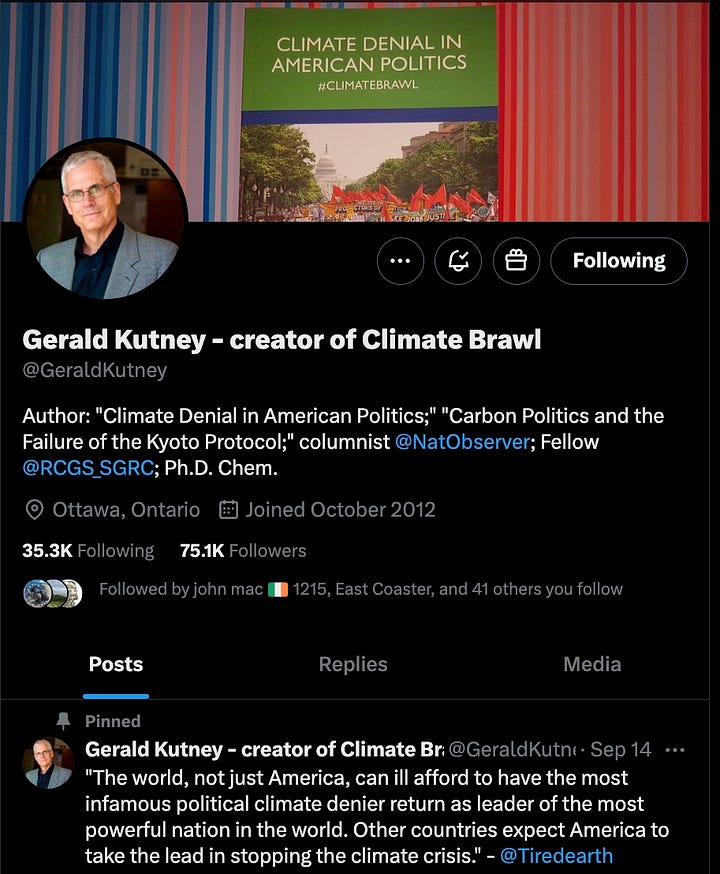
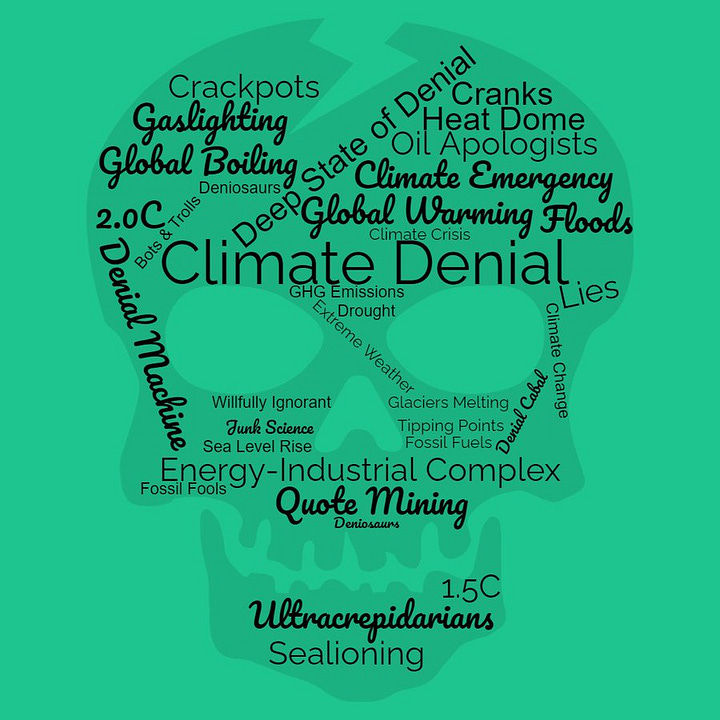
X Notes appends a disclaimer (Readers added context) to a post that provokes disagreement. Since the dominant narrative in mainstream media is that climate change is real and extreme weather events are increasing in number and intensity, consider this post as added context.
*On May 17, 1932, the President (Hoover) signed Pub. Res. No. 20, (47 Stat. 158) designating "Puerto" as the official spelling.


Weather(climate) is cyclic. Last year Texas was frozen and the wind mill blades were inoperable so producing power with them was pure folly. My Almanac says we'll have another cold winter ahead of us. Go figure.
Thanks for this Ross.
Scott Randle